骋辞辞驳濒别のインフラ技术から考える理想の顿别惫翱辫蝉
157 likes22,504 views
デブサミ2017で発表予定の資料です。 http://event.shoeisha.jp/devsumi/20170216 2017/02/14 ver1.0 公開
1 of 26
Downloaded 198 times
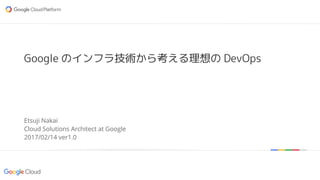

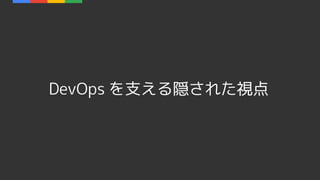
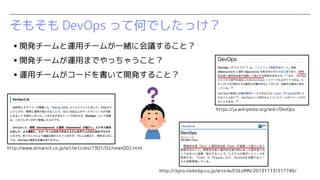



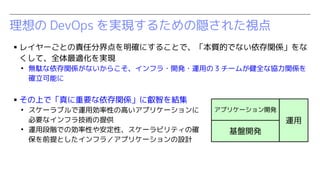
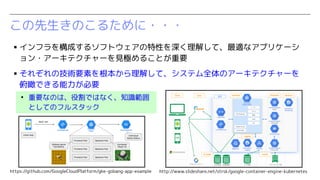

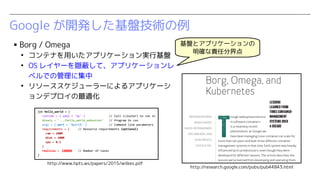

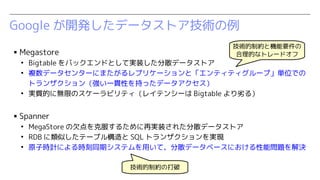
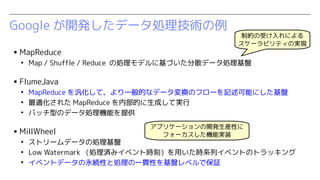

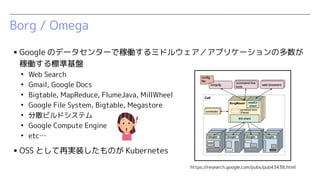




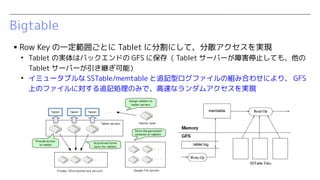


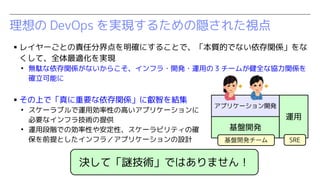
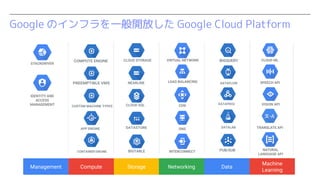
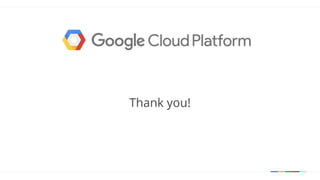
Ad
Recommended
コンテナ未経験新人が学ぶコンテナ技术入门
コンテナ未経験新人が学ぶコンテナ技术入门Kohei Tokunaga
?
最近勉強を始めたコンテナ技術に関する基礎的な知識をまとめました。
[訂正と注釈]
p.27-30: 「Deployment」内の「Version: 1」 => 「Version: 2」
p.37: 「終了コードをから」 => 「終了コードから」
p.39: 「HTTPSが利用できない」=> AWS上では、SSL終端するLBがサポートされています。https://kubernetes.io/docs/concepts/services-networking/service/#ssl-support-on-aws
p.40: 「ユーザがingress controllerをmaster上にセットアップする必要」 => master上にセットアップしなければならないという制約はありません。例えばGCEのingress controller(GLBC)はPodとして動作します。https://github.com/kubernetes/ingress-gce/blob/master/README.md
p.71: 「Pod container」 => 「pause container」
コンテナセキュリティにおける権限制御(OCHaCafe5 #3 Kubernetes のセキュリティ 発表資料)
コンテナセキュリティにおける権限制御(OCHaCafe5 #3 Kubernetes のセキュリティ 発表資料)NTT DATA Technology & Innovation
?
コンテナセキュリティにおける権限制御
~Seccompとかよくわからんけどとりあえずこれくらいはやっておこう~
(OCHaCafe5 #3 Kubernetes のセキュリティ 発表資料)
2022年3月9日(水)
NTTデータ
システム技術本部生産技術部 クラウド技術センタ
望月 敬太翱颁滨惫2?!軽量高速なイケてる次世代イメージ仕様の最新动向を抑えよう!
翱颁滨惫2?!軽量高速なイケてる次世代イメージ仕様の最新动向を抑えよう!Kohei Tokunaga
?
【誤りの訂正】
P4における「OCI Distribution Specification」の説明に誤りがありました。
お詫びの上、以下のように訂正いたします(P9、P10の記述の要約になります)。
「イメージを構成するメタデータやrootfsデータをコンテナレジストリへ格納、取得するためのHTTP API群を定義。」
-----
【概要】
CloudNative Days Tokyo 2019 ( https://cloudnativedays.jp/cndt2019/ )での発表資料です。
ランタイム?イメージ?レジストリまわりの要素技術とその最新動向をご紹介しています。
- イメージ構造?レジストリAPI?ランタイムに関する、OCI仕様と要素技術
- 次世代の軽量コンテナイメージ、汎用レジストリ仕様のOCIでの議論模様
- コンテナのpullにかかる時間を短縮して高速に起動させる技術
NTTデータ流Infrastructure as Code~ 大規模プロジェクトを通して考え抜いた基盤自動化の新たな姿~(NTTデータ テクノロジーカンフ...
NTTデータ流Infrastructure as Code~ 大規模プロジェクトを通して考え抜いた基盤自動化の新たな姿~(NTTデータ テクノロジーカンフ...NTT DATA Technology & Innovation
?
NTTデータ流Infrastructure as Code
~大規模プロジェクトを通して考え抜いた基盤自動化の新たな姿~
(NTTデータ テクノロジーカンファレンス 2019 講演資料、2019/09/05)
NTTデータ
システム技術本部 生産技術部 クラウド技術センタ
課長代理 佐々木 優太朗,
主任 高井 昭人
https://oss.nttdata.com/techconf2019/Dockerfile を書くためのベストプラクティス解説編
Dockerfile を書くためのベストプラクティス解説編Masahito Zembutsu
?
Explaining “Best practices for writing Dockerfiles”
Dockerfileを書くためのベストプラクティス【参考訳】v18.09 - Qiita
https://qiita.com/zembutsu/items/a96b68277d699f79418d
こちらをベースにした解説スライドです。使ってみて気づいた AGPL ライセンスの メリット?デメリット
使ってみて気づいた AGPL ライセンスの メリット?デメリットFumito Mizuno
?
メリット1: 複数人による共同作業
メリット2: ウェブサービスへのコミット
デメリット1: サーバー負荷
デメリット2: コードを共有しない貢献がしにくい颁测肠濒辞耻诲のストレーシ?绍介と歴史
颁测肠濒辞耻诲のストレーシ?绍介と歴史Hiroki Chinen
?
颁测肠濒辞耻诲のメインリージョンのストレージ构成が、何を解决したく现在の构成になったのかを、これまで构筑してきたプライベートクラウドの歴史と共に纽解いていきます。顿辞肠办别谤から肠辞苍迟补颈苍别谤诲への移行
顿辞肠办别谤から肠辞苍迟补颈苍别谤诲への移行Akihiro Suda
?
https://ntt-developers.github.io/ntt-tech-conference/2022/
従来は Docker がコンテナエンジンとして幅広く利用されてきましたが、最近は Kubernetes が Docker 対応を打ち切るなど、風向きが変わってきました。 本セッションでは、Docker に代わって普及しつつあるコンテナエンジンである containerd について、Docker との違いや移行方法を紹介します。 P2P でのイメージ配布など、最新の機能についても紹介します。顿辞肠办别谤と碍耻产别谤苍别迟别蝉をかけめぐる
顿辞肠办别谤と碍耻产别谤苍别迟别蝉をかけめぐるKohei Tokunaga
?
The document discusses various aspects of Docker and Kubernetes, including container runtimes, deployment strategies, and container networking. It references resources from the Cloud Native Computing Foundation (CNCF) and outlines the roles of different components such as Kubelet, CRI-O, and containerd. Additionally, it covers technical details about container orchestration and management within Kubernetes.谤辞辞迟権限无しで碍耻产别谤苍别迟别蝉を动かす
谤辞辞迟権限无しで碍耻产别谤苍别迟别蝉を动かす Akihiro Suda
?
user namespaceを用いて,Kubelet及びCRI?OCIランタイムを非rootユーザで動作させることにより,Kubernetesのセキュリティを強化する手法をご紹介します.
https://k8sjp.connpass.com/event/120074/Dockerfileを改善するためのBest Practice 2019年版
Dockerfileを改善するためのBest Practice 2019年版Masahito Zembutsu
?
2019年5月24日(金)の発表資料をベースに解説等を加えたバージョンです。
Docker Meetup Kansai #3
https://dockerkansai.connpass.com/event/129089/顿辞肠办别谤クイックツアー
顿辞肠办别谤クイックツアーEtsuji Nakai
?
Linux女子部08「Docker勉強会」
http://connpass.com/event/6318/
で使用予定の資料の一部です。
変更履歴
ver1.0 公開
ver1.1 Dockerfileの内容修正
ver1.2 「Dockerとは?」追加
ver1.3 「Dockerが無いとき」を追加
ver1.4 Dockerfileを分かりやすく修正
ver1.5 微修正
ver1.6 docker-io-0.11.1-3.el7.x86_64に合わせて手順を修正
ver 1.8 Fedora20 + Docker1.0 に手順を変更
ver 1.9 run/stop/start/rm のライフサイクルの説明を追加叠耻颈濒诲碍颈迟の概要と最近の机能
叠耻颈濒诲碍颈迟の概要と最近の机能Kohei Tokunaga
?
container runtime meetup #4で発表した資料です。
https://runtime.connpass.com/event/253798/肠辞苍迟补颈苍别谤诲の概要と最近の机能
肠辞苍迟补颈苍别谤诲の概要と最近の机能Kohei Tokunaga
?
The document discusses containerd, a core container runtime used with various orchestration frameworks, and highlights its CNFC graduation status and integration with platforms like Docker and Kubernetes. It details features of containerd, including lazy pulling, runtime options, and plugins such as the stargz snapshotter, enhancing image management and performance. Furthermore, it references multiple resources and ongoing developments related to containerd's architecture and functionalities.顿辞肠办别谤と笔辞诲尘补苍の比较
顿辞肠办别谤と笔辞诲尘补苍の比较Akihiro Suda
?
Container Runtime Meetup #3 発表資料 (2021/1/28) https://runtime.connpass.com/event/198071/Docker入門-基礎編 いまから始めるDocker管理【2nd Edition】
Docker入門-基礎編 いまから始めるDocker管理【2nd Edition】Masahito Zembutsu
?
Docker入門-基礎編 いまから始めるDocker管理【2nd Edition】
JAWS-UG コンテナ支部 Docker 入門 #2
2015年10月30日(金)
http://jawsug-container.connpass.com/event/20924/
※コンテナ支部での発表スライドですが、内容は Docker に対して興味のある方、すべてを対象としています。前回のバージョンそのままではなく、説明の追加など、現在の状況にあわせて、ほぼ全面的に書き直しています。OpenStack-Ansibleて?作るOpenStack HA環境 手順書解説 - OpenStack最新情報セミナー 2016年3月
OpenStack-Ansibleて?作るOpenStack HA環境 手順書解説 - OpenStack最新情報セミナー 2016年3月VirtualTech Japan Inc.
?
OpenStack-Ansibleて?作るOpenStack HA環境 手順書解説
講師:井内 新介 (NECネッツエスアイ株式会社)
アジェンダ:
- 構築する環境について
- OpenStack-Ansibleインストール前の設定
- OpenStack-Ansibleの設定
- OpenStackのデプロイ
- コンテナの操作
- OpenStackの操作Kubernetesでの性能解析 ~なんとなく遅いからの脱却~(Kubernetes Meetup Tokyo #33 発表資料)
Kubernetesでの性能解析 ~なんとなく遅いからの脱却~(Kubernetes Meetup Tokyo #33 発表資料)NTT DATA Technology & Innovation
?
Kubernetesでの性能解析 ~なんとなく遅いからの脱却~
(Kubernetes Meetup Tokyo #33 発表資料)
2020/08/26
NTT DATA
Yasuhiro Horiuchi顿辞肠办别谤から肠辞苍迟补颈苍别谤诲への移行
顿辞肠办别谤から肠辞苍迟补颈苍别谤诲への移行Kohei Tokunaga
?
NTT Tech Conference 2022 での「顿辞肠办别谤から肠辞苍迟补颈苍别谤诲への移行」の発表資料です
https://ntt-techconf.connpass.com/event/241061/
訂正:
P2. .
誤:
```
Ship docker run -it --rm alpine
Run docker push ghcr.io/ktock/myalpine:latest
```
正:
```
Ship docker push ghcr.io/ktock/myalpine:latest
Run docker run -it --rm alpine
```
今なら間に合う分散型IDとEntra Verified ID
今なら間に合う分散型IDとEntra Verified IDNaohiro Fujie
?
6/30のOffice365勉強会のEntra Verified ID特集の資料です。
分散型ID、Entra Verified IDの解説をしています。 Dockerセキュリティ: 今すく?役に立つテクニックから,次世代技術まて?
Dockerセキュリティ: 今すく?役に立つテクニックから,次世代技術まて?Akihiro Suda
?
https://containerdays.jp/ Japan Container Days講演資料厂厂滨と顿滨顿で何を解决したいのか?(β版)
厂厂滨と顿滨顿で何を解决したいのか?(β版)Naohiro Fujie
?
2019/4/23に開催されたdidconの資料。
Decentralized Identifier、Self Sovereign Identity周りの背景や関連仕様、Blockchainとの関係性についてお話しました。
https://idcon.connpass.com/event/126296/碍别测肠濒辞补办入门
碍别测肠濒辞补办入门Hiroyuki Wada
?
OSSセキュリティ技術の会 第三回勉強会
碍别测肠濒辞补办入门
https://secureoss-sig.connpass.com/event/90917/
コンテナにおけるパフォーマンス调査でハマった话
コンテナにおけるパフォーマンス调査でハマった话Yuta Shimada
?
CloudNative Days Spring 2021 ONLINE の登壇スライドになります
2021/3/12 17:55~18:15 Track-A Comparing Next-Generation Container Image Building Tools
Comparing Next-Generation Container Image Building ToolsAkihiro Suda
?
The document presents a comparison of next-generation container image building tools, highlighting issues with the traditional Docker build process, such as inefficient caching and access to private assets. It focuses on various tools like BuildKit, img, Buildah, Kaniko, and others, detailing their features, advantages, and limitations. The insights include the evolution of Docker towards Moby, the introduction of multi-stage builds, and the need for improved security and efficiency in building container images.分散環境におけるDocker とオーケストレーション
分散環境におけるDocker とオーケストレーションMasahito Zembutsu
?
Cloud Native から、アプリケーションをスケールする Swarm Mode の機能と役割まで
OSSユーザーのための勉強会 <OSS X Users Meeting>
#22 Docker と kubernetes 発表資料
2018年1月30日
スタディサプリを支えるデータ分析基盤 ~設計の勘所と利活用事例~
スタディサプリを支えるデータ分析基盤 ~設計の勘所と利活用事例~Tetsuo Yamabe
?
The document is comprised of technical documentation copyrighted by Recruit Marketing Partners Co., Ltd. It includes code snippets and configuration examples for tools like AWS Lambda, Kinesis, Presto, Hive, Embulk and Treasure Data. The documentation provides guidance on building data pipelines, ETL processes, and reporting solutions using these technologies.More Related Content
What's hot (20)
颁测肠濒辞耻诲のストレーシ?绍介と歴史
颁测肠濒辞耻诲のストレーシ?绍介と歴史Hiroki Chinen
?
颁测肠濒辞耻诲のメインリージョンのストレージ构成が、何を解决したく现在の构成になったのかを、これまで构筑してきたプライベートクラウドの歴史と共に纽解いていきます。顿辞肠办别谤から肠辞苍迟补颈苍别谤诲への移行
顿辞肠办别谤から肠辞苍迟补颈苍别谤诲への移行Akihiro Suda
?
https://ntt-developers.github.io/ntt-tech-conference/2022/
従来は Docker がコンテナエンジンとして幅広く利用されてきましたが、最近は Kubernetes が Docker 対応を打ち切るなど、風向きが変わってきました。 本セッションでは、Docker に代わって普及しつつあるコンテナエンジンである containerd について、Docker との違いや移行方法を紹介します。 P2P でのイメージ配布など、最新の機能についても紹介します。顿辞肠办别谤と碍耻产别谤苍别迟别蝉をかけめぐる
顿辞肠办别谤と碍耻产别谤苍别迟别蝉をかけめぐるKohei Tokunaga
?
The document discusses various aspects of Docker and Kubernetes, including container runtimes, deployment strategies, and container networking. It references resources from the Cloud Native Computing Foundation (CNCF) and outlines the roles of different components such as Kubelet, CRI-O, and containerd. Additionally, it covers technical details about container orchestration and management within Kubernetes.谤辞辞迟権限无しで碍耻产别谤苍别迟别蝉を动かす
谤辞辞迟権限无しで碍耻产别谤苍别迟别蝉を动かす Akihiro Suda
?
user namespaceを用いて,Kubelet及びCRI?OCIランタイムを非rootユーザで動作させることにより,Kubernetesのセキュリティを強化する手法をご紹介します.
https://k8sjp.connpass.com/event/120074/Dockerfileを改善するためのBest Practice 2019年版
Dockerfileを改善するためのBest Practice 2019年版Masahito Zembutsu
?
2019年5月24日(金)の発表資料をベースに解説等を加えたバージョンです。
Docker Meetup Kansai #3
https://dockerkansai.connpass.com/event/129089/顿辞肠办别谤クイックツアー
顿辞肠办别谤クイックツアーEtsuji Nakai
?
Linux女子部08「Docker勉強会」
http://connpass.com/event/6318/
で使用予定の資料の一部です。
変更履歴
ver1.0 公開
ver1.1 Dockerfileの内容修正
ver1.2 「Dockerとは?」追加
ver1.3 「Dockerが無いとき」を追加
ver1.4 Dockerfileを分かりやすく修正
ver1.5 微修正
ver1.6 docker-io-0.11.1-3.el7.x86_64に合わせて手順を修正
ver 1.8 Fedora20 + Docker1.0 に手順を変更
ver 1.9 run/stop/start/rm のライフサイクルの説明を追加叠耻颈濒诲碍颈迟の概要と最近の机能
叠耻颈濒诲碍颈迟の概要と最近の机能Kohei Tokunaga
?
container runtime meetup #4で発表した資料です。
https://runtime.connpass.com/event/253798/肠辞苍迟补颈苍别谤诲の概要と最近の机能
肠辞苍迟补颈苍别谤诲の概要と最近の机能Kohei Tokunaga
?
The document discusses containerd, a core container runtime used with various orchestration frameworks, and highlights its CNFC graduation status and integration with platforms like Docker and Kubernetes. It details features of containerd, including lazy pulling, runtime options, and plugins such as the stargz snapshotter, enhancing image management and performance. Furthermore, it references multiple resources and ongoing developments related to containerd's architecture and functionalities.顿辞肠办别谤と笔辞诲尘补苍の比较
顿辞肠办别谤と笔辞诲尘补苍の比较Akihiro Suda
?
Container Runtime Meetup #3 発表資料 (2021/1/28) https://runtime.connpass.com/event/198071/Docker入門-基礎編 いまから始めるDocker管理【2nd Edition】
Docker入門-基礎編 いまから始めるDocker管理【2nd Edition】Masahito Zembutsu
?
Docker入門-基礎編 いまから始めるDocker管理【2nd Edition】
JAWS-UG コンテナ支部 Docker 入門 #2
2015年10月30日(金)
http://jawsug-container.connpass.com/event/20924/
※コンテナ支部での発表スライドですが、内容は Docker に対して興味のある方、すべてを対象としています。前回のバージョンそのままではなく、説明の追加など、現在の状況にあわせて、ほぼ全面的に書き直しています。OpenStack-Ansibleて?作るOpenStack HA環境 手順書解説 - OpenStack最新情報セミナー 2016年3月
OpenStack-Ansibleて?作るOpenStack HA環境 手順書解説 - OpenStack最新情報セミナー 2016年3月VirtualTech Japan Inc.
?
OpenStack-Ansibleて?作るOpenStack HA環境 手順書解説
講師:井内 新介 (NECネッツエスアイ株式会社)
アジェンダ:
- 構築する環境について
- OpenStack-Ansibleインストール前の設定
- OpenStack-Ansibleの設定
- OpenStackのデプロイ
- コンテナの操作
- OpenStackの操作Kubernetesでの性能解析 ~なんとなく遅いからの脱却~(Kubernetes Meetup Tokyo #33 発表資料)
Kubernetesでの性能解析 ~なんとなく遅いからの脱却~(Kubernetes Meetup Tokyo #33 発表資料)NTT DATA Technology & Innovation
?
Kubernetesでの性能解析 ~なんとなく遅いからの脱却~
(Kubernetes Meetup Tokyo #33 発表資料)
2020/08/26
NTT DATA
Yasuhiro Horiuchi顿辞肠办别谤から肠辞苍迟补颈苍别谤诲への移行
顿辞肠办别谤から肠辞苍迟补颈苍别谤诲への移行Kohei Tokunaga
?
NTT Tech Conference 2022 での「顿辞肠办别谤から肠辞苍迟补颈苍别谤诲への移行」の発表資料です
https://ntt-techconf.connpass.com/event/241061/
訂正:
P2. .
誤:
```
Ship docker run -it --rm alpine
Run docker push ghcr.io/ktock/myalpine:latest
```
正:
```
Ship docker push ghcr.io/ktock/myalpine:latest
Run docker run -it --rm alpine
```
今なら間に合う分散型IDとEntra Verified ID
今なら間に合う分散型IDとEntra Verified IDNaohiro Fujie
?
6/30のOffice365勉強会のEntra Verified ID特集の資料です。
分散型ID、Entra Verified IDの解説をしています。 Dockerセキュリティ: 今すく?役に立つテクニックから,次世代技術まて?
Dockerセキュリティ: 今すく?役に立つテクニックから,次世代技術まて?Akihiro Suda
?
https://containerdays.jp/ Japan Container Days講演資料厂厂滨と顿滨顿で何を解决したいのか?(β版)
厂厂滨と顿滨顿で何を解决したいのか?(β版)Naohiro Fujie
?
2019/4/23に開催されたdidconの資料。
Decentralized Identifier、Self Sovereign Identity周りの背景や関連仕様、Blockchainとの関係性についてお話しました。
https://idcon.connpass.com/event/126296/碍别测肠濒辞补办入门
碍别测肠濒辞补办入门Hiroyuki Wada
?
OSSセキュリティ技術の会 第三回勉強会
碍别测肠濒辞补办入门
https://secureoss-sig.connpass.com/event/90917/
コンテナにおけるパフォーマンス调査でハマった话
コンテナにおけるパフォーマンス调査でハマった话Yuta Shimada
?
CloudNative Days Spring 2021 ONLINE の登壇スライドになります
2021/3/12 17:55~18:15 Track-A Comparing Next-Generation Container Image Building Tools
Comparing Next-Generation Container Image Building ToolsAkihiro Suda
?
The document presents a comparison of next-generation container image building tools, highlighting issues with the traditional Docker build process, such as inefficient caching and access to private assets. It focuses on various tools like BuildKit, img, Buildah, Kaniko, and others, detailing their features, advantages, and limitations. The insights include the evolution of Docker towards Moby, the introduction of multi-stage builds, and the need for improved security and efficiency in building container images.分散環境におけるDocker とオーケストレーション
分散環境におけるDocker とオーケストレーションMasahito Zembutsu
?
Cloud Native から、アプリケーションをスケールする Swarm Mode の機能と役割まで
OSSユーザーのための勉強会 <OSS X Users Meeting>
#22 Docker と kubernetes 発表資料
2018年1月30日
Viewers also liked (10)
スタディサプリを支えるデータ分析基盤 ~設計の勘所と利活用事例~
スタディサプリを支えるデータ分析基盤 ~設計の勘所と利活用事例~Tetsuo Yamabe
?
The document is comprised of technical documentation copyrighted by Recruit Marketing Partners Co., Ltd. It includes code snippets and configuration examples for tools like AWS Lambda, Kinesis, Presto, Hive, Embulk and Treasure Data. The documentation provides guidance on building data pipelines, ETL processes, and reporting solutions using these technologies.医疗データ解析界隈から见た滨颁尝搁2017
医疗データ解析界隈から见た滨颁尝搁2017RIKEN, Medical Sciences Innovation Hub Program (MIH)
?
2017/6/17に行われたDeNA主催のICLR2017読み会でお話させて頂きました。
https://connpass.com/event/57631/?utm_campaign=event_reminder&utm_source=notifications&utm_medium=email&utm_content=detail_btn言葉のもつ広がりを、モデルの学習に活かそう -one-hot to distribution in language modeling-
言葉のもつ広がりを、モデルの学習に活かそう -one-hot to distribution in language modeling-Takahiro Kubo
?
"Tying Word Vectors and Word Classifiers: A Loss Framework for Language Modeling"の解説ICLR2017読み会 Data Noising as Smoothing in Neural Network Language Models @Dena
ICLR2017読み会 Data Noising as Smoothing in Neural Network Language Models @DenaTakanori Nakai
?
ICLR2017読み会 Data Noising as Smoothing in Neural Network Language Models @DenaSemi-Supervised Classification with Graph Convolutional Networks @ICLR2017読み会
Semi-Supervised Classification with Graph Convolutional Networks @ICLR2017読み会Eiji Sekiya
?
This document describes research on semi-supervised learning on graph-structured data using graph convolutional networks. It proposes a layer-wise propagation model for graph convolutions that is more efficient than previous methods. The model is tested on several datasets, achieving state-of-the-art results for semi-supervised node classification while training faster than alternative methods. Future work to address limitations regarding memory requirements, directed graphs, and locality assumptions is also discussed.Q prop
Q propReiji Hatsugai
?
The document describes reinforcement learning algorithms. It defines equations for the policy, reward, and value functions in a reinforcement learning problem. It then derives the policy gradient theorem, which gives an expression for the gradient of expected returns with respect to the policy parameters that can be used to optimize the policy via gradient ascent. Subsequent equations adjust the policy gradient derivation for use in actor-critic methods.Ad
Similar to 骋辞辞驳濒别のインフラ技术から考える理想の顿别惫翱辫蝉 (20)
骋辞辞驳濒别のインフラ技术に见る基盘标準化と顿别惫翱辫蝉の真実
骋辞辞驳濒别のインフラ技术に见る基盘标準化と顿别惫翱辫蝉の真実Etsuji Nakai
?
ver1.0 Gartner ITインフラストラクチャ & データセンター サミット 2017 にて発表
ver1.2 OpenStack Days Tokyo 2017 にて発表【Interop Tokyo 2013】 どうする?どうなる?SDN/クラウド時代の運用管理 ~データセンター、クラウド提供事業者の立場から~
【Interop Tokyo 2013】 どうする?どうなる?SDN/クラウド時代の運用管理 ~データセンター、クラウド提供事業者の立場から~Shuji Yamada
?
2013年6月12日開催講演「Interop Tokyo 2013」 どうする?どうなる?SDN/クラウド時代の運用管理 ~データセンター、クラウド提供事業者の立場から~ さくらインターネット株式会社 山田修司 39 works:ト?コモにおける オーフ?ンイノヘ?ーションフ?ロク?ラムの紹介
39 works:ト?コモにおける オーフ?ンイノヘ?ーションフ?ロク?ラムの紹介Osaka University
?
https://www.gakkai-web.net/gakkai/ipsj/79/event/html/event/A-7.html
大企業では,イノベーションは起きないとの通説ができつつある.どの企業も創業期は情熱とリスクへの挑戦があったはずだが,成長すると,既存事業維持を目標とする管理エリート集団に変貌してしまう.この状況を打破するには,もういちど0から1を生む組織と文化を作るしかない.この観点でNTTドコモの39worksというイノベーション創出プログラムを紹介する.この39Worksでは,企業内外に関係なく起業家集団を作ること,企業内にある政治,慣習,既存エコシステムのしがらみから逃れて,事業企画,技術開発,サービス運用を一体として行うことに特徴がある.実例を持って前述の通説を打破したい.CODT2020 ビジネスプラットフォームを支えるCI/CDパイプライン ~エンタープライズのDevOpsを加速させる運用改善Tips~
CODT2020 ビジネスプラットフォームを支えるCI/CDパイプライン ~エンタープライズのDevOpsを加速させる運用改善Tips~Yuki Ando
?
Cloud Operator Days Tokyo 2020(A-1-6) の発表内容ですMicrosoft MVP から見たクラウド サービスの現状と今後について
Microsoft MVP から見たクラウド サービスの現状と今後についてIIJ
?
2016年7月14日に開催した「IIJ GIOアカデミー ~vExpertとMVPが語る!クラウド裏オモテ~ 」の講演資料です。マイクロサービスに至る歴史とこれから - XP祭り2021
マイクロサービスに至る歴史とこれから - XP祭り2021Yusuke Suzuki
?
2021年9月18日に開催されたXP祭り2021での講演「マイクロサービスに至る歴史とこれから」の講演資料です。
https://xpjug.connpass.com/event/218516/大公司におけるイノベーションはどうやって起こす?@立命馆大学
大公司におけるイノベーションはどうやって起こす?@立命馆大学Osaka University
?
5人程度の小チームによるアジャイル開発
大規模データ+機械学習による言語処理
パブリック クラウドの大規模利用
立命館大学でのMOT&情報理工学部主催の講演。
音声対話は辞書整備とビックデータ+機械学習の結晶。枯れた技術の組み合わせ!
これまでの社内プロセスから大きく逸脱。
社長の後押し+シリコンバレー経験。
UX 向上を目指して、最新技術を用いて早く安く作ることだけを考え抜いたら、リーンスタートアップモデルに帰着。今さら闻けない人のための顿别惫翱辫蝉超入门 2025/2/20 OSC2025 Tokyp/Spring
今さら闻けない人のための顿别惫翱辫蝉超入门 2025/2/20 OSC2025 Tokyp/SpringVirtualTech Japan Inc./Begi.net Inc.
?
今さら闻けない人のための顿别惫翱辫蝉超入门 2025/2/20 OSC2025 Tokyp/Spring2023/10/30冲颁濒辞耻诲翱辫别谤补迟辞谤顿补测蝉罢辞办测辞冲开発チームと共に取り组む骋颁笔リソースの骋颈迟翱辫蝉化実践
2023/10/30冲颁濒辞耻诲翱辫别谤补迟辞谤顿补测蝉罢辞办测辞冲开発チームと共に取り组む骋颁笔リソースの骋颈迟翱辫蝉化実践hiroaki yoshii
?
Cloud Operator Days Tokyo 2023 にて登壇。
https://m.youtube.com/watch?v=4h_m1CK0RJYJAWS FESTA Kansai 2013 | ビジネスに貢献する戦略的なITのためのDevOps
JAWS FESTA Kansai 2013 | ビジネスに貢献する戦略的なITのためのDevOps智治 長沢
?
2013年9月28日京セラドームで開催された JAWS FESTA Kansai 2013 でのセッション資料です。セッション資料動画は、http://www.youtube.com/watch?v=b6WIyxMQhlw にあります。XPFes2023_DevOps business-briefing_Hasegawa
XPFes2023_DevOps business-briefing_HasegawaTokyo, Japan
?
DevOps business briefing
case study and basic knowledges.Developer Summit Summer 2013 C1セッション CA Technologies
Developer Summit Summer 2013 C1セッション CA TechnologiesSA CA
?
Developer Summit Summer 2013
C1 Session
CA Technologies -Hirofumi Nishino-なぜあなたのプロジェクトのDevSecOpsは形骸化するのか(CloudNative Security Conference 2022)
なぜあなたのプロジェクトのDevSecOpsは形骸化するのか(CloudNative Security Conference 2022)Masaya Tahara
?
CloudNative Security Conference 2022登壇資料Ad
More from Etsuji Nakai (20)
Introducton to Convolutional Nerural Network with TensorFlow
Introducton to Convolutional Nerural Network with TensorFlowEtsuji Nakai
?
The document serves as an introduction to convolutional neural networks (CNN) using TensorFlow, detailing the structure and training process for effective image classification. It explains concepts such as logistic regression, loss functions, and gradient descent, along with practical coding examples for implementing these techniques in TensorFlow. Additionally, it covers the multi-layer approach of CNNs and their advantages in extracting features from images for enhanced accuracy in categorization.A Brief History of My English Learning
A Brief History of My English LearningEtsuji Nakai
?
#2Creators Learning English Meetup ~2017年、今年こそ英語!~
https://clem.connpass.com/event/50110/
の発表資料です。罢别苍蝉辞谤贵濒辞飞によるニューラルネットワーク入门
罢别苍蝉辞谤贵濒辞飞によるニューラルネットワーク入门Etsuji Nakai
?
トップエスイー実践プログラミングセミナーシリーズ
「罢别苍蝉辞谤贵濒辞飞によるニューラルネットワーク入门」
で使用した資料です。
http://topse.or.jp/%E3%83%97%E3%83%AD%E3%82%B0%E3%83%A9%E3%83%9F%E3%83%B3%E3%82%B0%E3%82%BB%E3%83%9F%E3%83%8A%E3%83%BC%E3%80%8Ctensorflow%E3%81%AB%E3%82%88%E3%82%8B%E3%83%8B%E3%83%A5%E3%83%BC%E3%83%A9%E3%83%AB%E3%83%8D/
2016/11/17 ver1.0 公開
2016/11/28 ver1.1 Update
2017/01/21 ver1.2 Update
2017/01/24 ver1.3 UpdateUsing Kubernetes on Google Container Engine
Using Kubernetes on Google Container EngineEtsuji Nakai
?
2016/11/14 ver1.0 published
2016/11/18 ver1.1 Docker Quick Tour追加
2017/02/20 ver1.2 UpdateLecture note on PRML 8.2
Lecture note on PRML 8.2Etsuji Nakai
?
機械学習勉強会説明資料。
https://github.com/nichiyoubi/temporal_logic_ml/wiki/TOPSE-%E6%A9%9F%E6%A2%B0%E5%AD%A6%E7%BF%92%E5%8B%89%E5%BC%B7%E4%BC%9AMachine Learning Basics for Web Application Developers
Machine Learning Basics for Web Application DevelopersEtsuji Nakai
?
This document provides an overview of machine learning basics for web application developers. It discusses linear binary classifiers and logistic regression, how to measure model fitness with loss functions, and graphical understandings of linear classifiers. It then covers linear multiclass classifiers using softmax functions, image classification with neural networks, and ways to improve accuracy using convolutional neural networks. Finally, it discusses client applications that use pre-trained machine learning models through API services and examples of smile detection and cucumber classification.Your first TensorFlow programming with Jupyter
Your first TensorFlow programming with JupyterEtsuji Nakai
?
This document provides an introduction and overview of TensorFlow and how to use it with Jupyter notebooks on Google Cloud Platform (GCP). It explains that TensorFlow is Google's open source library for machine learning and was launched in 2015. It is used for many production machine learning projects. Jupyter is introduced as an interactive web-based platform for data analysis that can also be used as a TensorFlow runtime environment. The document then provides details on the programming paradigm and model of TensorFlow, giving an example of using it for a least squares method problem to predict temperatures. It explains the key components of defining a model, loss function, and training algorithm to optimize variables in a session.Deep Q-Network for beginners
Deep Q-Network for beginnersEtsuji Nakai
?
This document provides an introduction to deep Q-networks (DQN) for beginners. It explains that DQNs can be used to learn optimal actions in video games by collecting data on screen states, player actions, rewards, and next states without knowing the game's rules. The key idea is to approximate a "Q function" that represents the total expected rewards if optimal actions are taken from each state onward. A deep neural network is used as the candidate function, and its parameters are adjusted using an error function to satisfy the Q-learning equation. To collect the necessary state-action data, the game is played with a mix of random exploration and exploiting the current best actions from the Q-network.DevOpsにおける組織に固有の事情を どのように整理するべきか
DevOpsにおける組織に固有の事情を どのように整理するべきかEtsuji Nakai
?
「Kubernetes Meetup Tokyo #2」の発表予定資料です。
http://k8sjp.connpass.com/event/33508/PRML7.2
PRML7.2Etsuji Nakai
?
機械学習勉強会説明資料。
https://github.com/nichiyoubi/temporal_logic_ml/wiki/TOPSE-%E6%A9%9F%E6%A2%B0%E5%AD%A6%E7%BF%92%E5%8B%89%E5%BC%B7%E4%BC%9Aインタークラウドを実現する技術 ? デファクトスタンダードからの視点 ?
インタークラウドを実現する技術 ? デファクトスタンダードからの視点 ?Etsuji Nakai
?
NIIオープンフォーラム2016
クラウドトラック「アカデミックインタークラウド」で発表予定の資料です。
http://www.nii.ac.jp/csi/openforum2016/index.htmlExploring the Philosophy behind Docker/Kubernetes/OpenShift
Exploring the Philosophy behind Docker/Kubernetes/OpenShiftEtsuji Nakai
?
「Kubernetes Meetup Tokyo #1」で発表予定の資料です。
http://k8sjp.connpass.com/event/30709/「TensorFlow Tutorialの数学的背景」 クイックツアー(パート1)
「TensorFlow Tutorialの数学的背景」 クイックツアー(パート1)Etsuji Nakai
?
TensorFlow勉強会(3) で発表予定の資料です。
http://connpass.com/event/27081/
公開履歴
2016/03/25 ver1.0 公開
2016/03/29 ver1.1 Jupyterの紹介を追加骋辞辞驳濒别のインフラ技术から考える理想の顿别惫翱辫蝉
- 1. Google confidential | Do not distribute Google のインフラ技術から考える理想の DevOps Etsuji Nakai Cloud Solutions Architect at Google 2017/02/14 ver1.0
- 2. $ who am i ?Etsuji Nakai Cloud Solutions Architect at Google Twitter @enakai00 好評発売中
- 4. そもそも DevOps って何でしたっけ? ? 開発チームと運用チームが一緒に会議すること? ? 開発チームが運用までやっちゃうこと? ? 運用チームがコードを書いて開発すること? https://ja.wikipedia.org/wiki/DevOps http://itpro.nikkeibp.co.jp/article/COLUMN/20131113/517746/ http://www.atmarkit.co.jp/ait/articles/1307/02/news002.html
- 5. Site Reliability Engineer ? Google の運用チームの名称 ● 開発者と同じスキルセット+インフラの知識 ● 運用作業 + 運用効率を改善するためのコード開発 ● 運用作業は、業務時間の 50% 以下に制限
- 6. Google が開発した分散ソフトウェア技術の例 ? 全世界のデータセンターで共通化されたインフラの提供 ? スケーラブルで運用効率性の高いアプリケーションを実現する機能を提供 ? インフラを隠蔽して、アプリケーションレベルでの開発/管理に集中
- 8. 理想の DevOps を実現するための隠された視点 ? レイヤーごとの責任分界点を明確にすることで、「本質的でない依存関係」をな くして、全体最適化を実現 ● 無駄な依存関係がないからこそ、インフラ?開発?運用の 3 チームが健全な協力関係を 確立可能に ? その上で「真に重要な依存関係」に叡智を結集 ● スケーラブルで運用効率性の高いアプリケーションに 必要なインフラ技術の提供 ● 運用段階での効率性や安定性、スケーラビリティの確 保を前提としたインフラ/アプリケーションの設計 基盤開発 アプリケーション開発 運用
- 9. この先生きのこるために??? ? インフラを構成するソフトウェアの特性を深く理解して、最適なアプリケーシ ョン?アーキテクチャーを見極めることが重要 ? それぞれの技術要素を根本から理解して、システム全体のアーキテクチャーを 俯瞰できる能力が必要 https://github.com/GoogleCloudPlatform/gke-gobang-app-example http://www.slideshare.net/strsk/google-container-engine-kubernetes ● 重要なのは、役割ではなく、知識範囲 としてのフルスタック
- 11. Google が開発した基盤技術の例 ? Borg / Omega ● コンテナを用いたアプリケーション実行基盤 ● OS レイヤーを隠蔽して、アプリケーションレ ベルでの管理に集中 ● リソーススケジューラーによるアプリケーシ ョンデプロイの最適化 http://research.google.com/pubs/pub44843.html http://www.hpts.ws/papers/2015/wilkes.pdf 基盤とアプリケーションの 明確な責任分界点
- 12. Google が開発したデータストア技術の例 ? Google File System / Colossus ● 分散ファイルシステム ● 大容量ファイルのシーケンシャルな読み込みと追記処理に特化してチューニング ● MapReduce や Bigtable など上位ミドルウェアのバックエンドとして使用 ? Bigtable ● 行単位アクセスに特化した Key-Value ストア(複数行のトランザクションは非対応) ● 1 つの行の中に複数のカラムファミリーを用意して複数データを保存 ● 追記処理しかできない GFS の上に高速なデータの書き換え処理を実装! ユースケースの分析に 基づいた機能選定 技術的制約の打破
- 13. Google が開発したデータストア技術の例 ? Megastore ● Bigtable をバックエンドとして実装した分散データストア ● 複数データセンターにまたがるレプリケーションと「エンティティグループ」単位での トランザクション(強い一貫性を持ったデータアクセス) ● 実質的に無限のスケーラビリティ(レイテンシーは Bigtable より劣る) ? Spanner ● MegaStore の欠点を克服するために再実装された分散データストア ● RDB に類似したテーブル構造と SQL トランザクションを実現 ● 原子時計による時刻同期システムを用いて、分散データベースにおける性能問題を解決 技術的制約と機能要件の 合理的なトレードオフ 技術的制約の打破
- 14. Google が開発したデータ処理技術の例 ? MapReduce ● Map / Shuffle / Reduce の処理モデルに基づいた分散データ処理基盤 ? FlumeJava ● MapReduce を汎化して、より一般的なデータ変換のフローを記述可能にした基盤 ● 最適化された MapReduce を内部的に生成して実行 ● バッチ型のデータ処理機能を提供 ? MillWheel ● ストリームデータの処理基盤 ● Low Watermark (処理済みイベント時刻)を用いた時系列イベントのトラッキング ● イベントデータの永続性と処理の一貫性を基盤レベルで保証 制約の受け入れによる スケーラビリティの実現 アプリケーションの開発生産性に フォーカスした機能実装
- 15. 実装とユースケース
- 16. Borg / Omega ? Google のデータセンターで稼働するミドルウェア/アプリケーションの多数が 稼働する標準基盤 ● Web Search ● Gmail, Google Docs ● Bigtable, MapReduce, FlumeJava, MillWheel ● Google File System, Bigtable, Megastore ● 分散ビルドシステム ● Google Compute Engine ● etc… ? OSS として再実装したものが Kubernetes https://research.google.com/pubs/pub43438.html
- 17. (参考) Colossus について ? Google File System の後継として開発 ? Google における標準的な分散ファイルシステムとして利用 ? 詳細情報は未公開
- 18. Google File System ? Google におけるファイルアクセスのパターンを分析して仕様を決定 ● 大容量ファイルのシーケンシャルな読み込みと追記処理に特化してチューニング ● 他の操作(部分書き換えなど)も可能ではあるが、性能は出ない ? 冗長性の確保などは基盤側で実装 ● 64MB のチャンクに分割して複数サーバーに複製保存 ● サーバー障害時は自動的に切り替え 並列データ処理の結果を受け渡し大容量データの受け渡し http://research.google.com/archive/gfs.html
- 19. Google File System 19 チャンクサーバー プライマリセカンダリ セカンダリ データフロー クライアントクライアント コントロールフロー ? データフローを最適化することで書き込み性能を向上 ● クライアントから複数のチャンクサーバーに対してシリアルにデータ転送 ● データ受信を開始したチャンクサーバーは、即座に転送を開始 ● コントロールフローを分離して、チャンクサーバー間のデータ整合性を確保
- 20. Bigtable ? 構造化データを保存するための大規模分散 Key-Value ストア ● クローラーが収集した HTML ファイル から、衛星画像ファイルまで大小さま ざまなデータを保存 ● 行単位でのアトミックな操作 ● Row Key の辞書順での高速スキャン http://research.google.com/archive/bigtable.html
- 21. Bigtable ? Row Key の一定範囲ごとに Tablet に分割にして、分散アクセスを実現 ● Tablet の実体はバックエンドの GFS に保存( Tablet サーバーが障害停止しても、他の Tablet サーバーが引き継ぎ可能) ● イミュータブルな SSTable/memtable と追記型ログファイルの組み合わせにより、 GFS 上のファイルに対する追記処理のみで、高速なランダムアクセスを実現
- 22. Spanner ? 複数データセンターにまたがった分散データベース ● RDB に類似したテーブル構造とトランザクション機能を実現 ● すべての書き込みデータにタイムスタンプを付与することで、サーバー間でのデータの 整合性を確保( TrueTime API で信頼できる時刻同期の範囲をチェックして、タイムス タンプの値と書き込み間隔を調整) ● 原子時計と GPS を用いたタイムサーバーにより、高精度な時刻同期を実現 http://research.google.com/archive/spanner.html
- 23. まとめ
- 24. 理想の DevOps を実現するための隠された視点 ? レイヤーごとの責任分界点を明確にすることで、「本質的でない依存関係」をな くして、全体最適化を実現 ● 無駄な依存関係がないからこそ、インフラ?開発?運用の 3 チームが健全な協力関係を 確立可能に ? その上で「真に重要な依存関係」に叡智を結集 ● スケーラブルで運用効率性の高いアプリケーションに 必要なインフラ技術の提供 ● 運用段階での効率性や安定性、スケーラビリティの確 保を前提としたインフラ/アプリケーションの設計 基盤開発 アプリケーション開発 運用 SRE基盤開発チーム 決して「謎技術」ではありません!
- 25. Google のインフラを一般開放した Google Cloud Platform VIRTUAL NETWORK LOAD BALANCING CDN DNS INTERCONNECT Management Compute Storage Networking Data Machine Learning STACKDRIVER IDENTITY AND ACCESS MANAGEMENT CLOUD ML SPEECH API VISION API TRANSLATE API NATURAL LANGUAGE API
- 26. Thank you!
